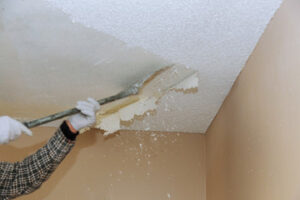Ceilings provide insulation and aesthetic value to the home, but they can also suffer damage from various causes. Recognizing these issues early allows for timely interventions and cost-effective repairs.

Hairline cracks in the ceiling can be cosmetic and may require simple joint compound or drywall mud patching. However, larger cracks could indicate underlying structural issues like rotting or damaged trusses that require attention. Contact Ceiling Repairs Perth for professional help.
As homes and buildings age, cracks in the ceiling can be expected to happen. Sometimes, this is a sign of structural damage that needs to be addressed, and other times it simply means normal wear and tear. However, ignoring these cracks can lead to serious damage to the structure of the building over time.
It is important to take ceiling cracks seriously and have them professionally assessed as soon as possible. This will help to prevent them from getting worse and potentially causing health issues for those living inside the home.
Hairline cracks in the ceiling that are less than 1/16 inch wide are usually not a cause for concern and can be caused by paint build-up, plaster expanding and shrinking due to humidity changes, or they could be caused by the shift of joists. Wider cracks in the ceiling are more of a problem and can be caused by foundation shifting, settling of walls or floors, and can also be a sign of a leak if they’re running parallel to the joists.
If you do notice a crack in the ceiling, it is important to have this repaired immediately as ignoring it can lead to water damage and even mold infiltration into the building. This will not only create a health issue for anyone living inside the home, but it can be very expensive to clean up and repair.
To fix ceiling cracks, you’ll need a ladder and a ladder stand, some joint compound (or drywall mud), some spackle, and a premixed drywall tape. Before starting, it is best to lay down a tarp or piece of plastic in the area where you’re working to catch any falling debris. Then, set up your ladder and make sure that you can reach the crack you’re looking to repair. Start by cleaning out the crack and then apply your first coat of quick setting joint compound. After this has dried, you can apply your drywall mud and then finish it off with some spackle or more joint compound. It’s important to use a good quality product so that your repair will last.
Water Stains
Whether they’re caused by leaking roofs, dripping water pipes or condensation buildup, water stains on ceilings aren’t just unsightly; they can lead to structural damage and promote mold growth, both of which require prompt repair. Ceilings play a critical role in a home’s insulation, soundproofing and overall safety. They need to be kept free from damage and moisture, so the best way to do this is to address problems as soon as they’re spotted.
While covering up the stain may seem like a quick fix, this is a mistake. If you don’t fix the root cause of the issue, it will reappear, causing further problems and possibly requiring expensive repairs down the line. Instead, you should always find and address the source of the problem.
This will usually be found by finding where the stain is coming from. If you’re unsure where it is coming from, start by examining the surrounding area to see where the most water stains are. Then, look at what’s directly above that area – for example, the roof, upstairs bathroom or any other room. Once you’ve found the leak, make sure to replace any damaged drywall and fix any water damage.
After fixing the leak, you can begin to clean the stains on your ceiling. To do this, mix equal parts white vinegar and warm water in a bucket. Dip a soft-bristled brush or sponge into the solution and then gently scrub away the stain. After scrubbing, rinse the area thoroughly with clean water and then let it dry completely.
Once the stain is clean, you can use a stain-blocking primer to help cover it up. It’s best to choose one that’s oil-based rather than latex, as it will be more effective at hiding the stain and is less likely to peel. After applying the primer, repaint with a color that matches the rest of the ceiling for a uniform appearance.
Water stains on ceilings can be unsightly and frustrating, but they don’t have to be permanent. With the right care, you can keep your home’s structure safe and looking great for years to come.
Leaks
A ceiling leak may not appear as a serious problem at first glance, but if left unchecked it can lead to structural damage or mold. Ceiling leaks are typically a sign of either a plumbing problem or a roof issue. Both of these problems can be expensive and difficult to resolve, but identifying the problem quickly can prevent further damage.
The first step in repairing a ceiling leak is to identify the source of the water. This can be done by observing the water pattern or looking for signs of moisture such as dark spots and peeling paint. Homeowners can also check the attic or roof to see if there are any issues that could be causing the leak.
Once the source of the leak has been identified, it is important to stop the flow of water. This can be done by using a bucket or putting a towel under the leak. It is then necessary to dry the area and clean away any wet materials. Homeowners can use fans and dehumidifiers to speed up the drying process.
Next, homeowners should cut back the drywall to the closest joists in order to attach a new sheet of drywall. Once the drywall is attached, it is then possible to patch any holes and coat with plaster compound. This can be sanded and then painted, providing a seamless finish to the ceiling.
For larger areas of leaking, it is often best to call in a professional. A professional can handle larger areas of drywall repair and can help find the source of the water leak. They can also provide services such as water damage mitigation and restoration, which may be needed if there is extensive water damage and mold growth.
Often, when a leak is discovered on a ceiling, there will be additional damage in other parts of the house. If there is mold or mildew present, this will need to be dealt with before any further work can be carried out on the affected areas of the ceiling. This can be done by re-caulking or resealing bathroom fixtures, and installing exhaust fans in bathrooms and kitchens.
Maintenance
The ceiling is a vital part of any home, and one that can be easy to forget until there’s a problem. Fortunately, with regular inspections, homeowners can identify early signs of problems like cracks, stains and water damage and take steps to resolve them before they escalate. Inspecting a home regularly can also help prevent the need for costly repairs in the future, such as replacing a sagging or damaged support beam.
While DIY fixes to small dents or holes in the ceiling are possible, it’s important to have the proper tools and knowledge for this type of project before starting. You’ll need drywall tape, joint compound or spackle, and sandpaper. Ensure that you have enough of each to cover the entire area of damage and to make sure you’re properly patching, smoothing and sanding the repaired area. You may also want to purchase a primer that’s compatible with your ceiling paint, as it will be used to help the patched areas blend in.
More serious drywall issues can be addressed with the application of a patching compound, followed by sanding and priming before repainting. This process is more involved than simply covering a ding or hole in the ceiling with paint, as it requires a fine touch and attention to detail.
If plaster has become crumbling or peeling due to moisture infiltration, it can be restored using spackling or joint compound. Plaster can also be replaced with modern drywall solutions if needed.
Damaged plaster can cause a loss of structural integrity, especially in older homes. Depending on the severity, this can lead to major repair costs and structural changes.
Structural damage is a concern that should only be tackled by an experienced professional, and one who is familiar with repairing ceilings. This type of work may require the use of power tools, and it’s recommended that you turn off electricity to any fixtures in the area where the repairs are being made. You’ll also need to take safety precautions, and lay down drop cloths to protect the flooring below. Taking this approach will not only help you avoid costly mistakes but also save time and energy that would be required if you were to do the repair work yourself.




